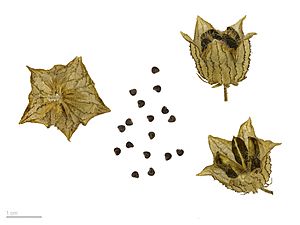Flower-of-an-hour facts for kids
Quick facts for kids Hibiscus trionumFlower-of-an-hour |
|
|---|---|
 |
|
| Hibiscus trionum flower | |
| Scientific classification | |
| Kingdom: | |
| (unranked): | |
| (unranked): | |
| (unranked): | |
| Order: | |
| Family: | |
| Genus: | |
| Binomial name | |
| Hibiscus trionum |
|
Hibiscus trionum, also known as the Flower-of-an-Hour, is a beautiful plant. It grows every year from a seed, meaning it's an annual plant. This flower is originally from the eastern part of the Mediterranean Sea, in a region called the Levant.
About the Flower-of-an-Hour
This plant has become very popular around the world. People often grow it in their gardens because its flowers are so pretty. However, it can also grow wild as a weed in some areas.
Where It Grows
The Flower-of-an-Hour first came from the sunny lands near the eastern Mediterranean. This includes countries like Israel, Lebanon, and Palestine. From there, it has spread to many other places. It can now be found in gardens and fields across different continents.
What It Looks Like
The Hibiscus trionum plant usually grows to be about 20 to 50 centimeters tall. Sometimes, it can even reach up to 80 centimeters. Its most striking feature is its flowers. These flowers are usually white or yellow. They have a dark purple center, which makes them stand out.
Common Names for This Plant
This plant has many different common names. People call it bladder hibiscus or bladder ketmia. Other names include bladder weed, flower-of-an-hour, and flower-of-the-hour. It is also known as modesty, puarangi, shoofly, and venice mallow. Each name often describes a feature or how it grows.


